Dr Don Hoover FGA, FGAA (Hon.)
Presented to the Gemmological Seminar of the 61st Annual Federal Conference of the GAA, which was held at Hadley’s Hotel, 34 Murray St, Hobart, Tasmania on Saturday 19th May 2007.
The theme of this year’s conference is the Old World, suggesting that we take a look back in time. So today, I hope you will accompany me on a trip looking at the history of gems. For me, the fascination of what our predecessors thought and believed about gems is enough reason for the trip. But, since I may not be preaching to the choir, I hope to demonstrate how such a journey can be of benefit in your profession, and hopefully inform and amuse you as well.
But, before I start with the tales, I would like to address a serious problem in all the sciences; that of fabrication of information or data. Thomas Katz, of the Chemistry Department , Columbia University, in a letter to the journal Science, points out that not enough attention is paid to what he calls “sham publication in secondary literature”, citing an experiment mentioned in various review papers, and related to a Nobel prize—but which never took place. By secondary literature Katz means review or summary papers, text books and such. He goes on to say that “frequent repetition can turn fictional breakthroughs into common lore. Science doesn’t always correct; it has to be corrected.” I would suggest that the same is especially true of our science of gemmology, because so much “romancing of the stone” takes place. Be assured, I have no problem with romancing the stone; I just want the stories or tales to be accurate. You will see examples of what I mean in what follows.
Since most of you have been students of gemmology, you will be quite aware that, typically, little is taught on the historical aspects of gemstones in your course work. For instance, how many in this audience know when thermal and magnetic properties were first used in gem testing, or when pink topaz was first discovered in Russia? I will address questions like these in what follows to illustrate how answers to such questions may help in your work. No matter what your area of interest in gemmology, I believe a study of gem history should help in the purchase or selling of stones, in romancing the stones, and in better understanding of the tools of our trade.
To start, let me read you a translation from an important earlier book on gems to take a look at some of the methods used earlier. This passage is in regards to testing of gems. It says:
I on the other hand am prepared to explain the methods of detecting false gems, since it is only fitting that even luxury should be protected against deception. Apart, then, from the details that I have given in describing the best stones of each class, it is recommended that transparent stones in general should be tested early in the morning or, if necessary, up to about ten o’clock, but on no account later than this. Tests are made in many different ways: first by weight because genuine stones are heavier; then by coolness, since genuine stones also feel colder in the mouth; and after this by structure. For artificial stones show globules deep below the surface, rough patches on the surface itself, filaments, an inconsistent luster and a brightness that fails to strike the eye. The most effective test is to knock off a piece of the stone so that it can be baked on an iron plate, but dealers in precious stones not unnaturally object to this, and likewise to testing with a file.
By the time this author wrote, density and thermal inertia, as well as the internal and external features of gems and their optical properties, were important in testing as they are today. Fusability is seldom used today, and many of you may not even remember when fusability and roasting on a charcoal block were common tests with minerals. Especially note that by this time scratch hardness testing was frowned upon. My point is that much of what was done in the past is still done today, but usually with improved equipment or techniques. Now, does anyone in this audience recognize this passage, and in what century it was written? Clearly it was prior to the late 19th century; but by how much? Any guesses??
I suspect that many of you will be surprised that this is from book 37 of Pliny the Elder’s Natural History, written about 70 CE, almost 2,000 years ago! Pliny is great fun to read today; just try and guess what modern gems are being talked about based on his descriptions. His topazus, chrysoberulli, or crysoprasum are not quite the same gems we know by similar names today. One can spend quite a bit of time with Pliny, but as time is short, I’ll now skip to more recent history.
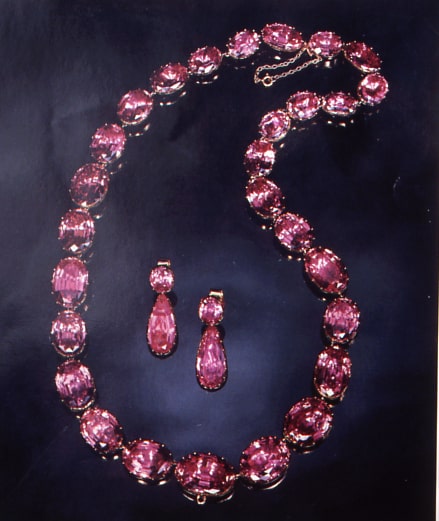
Next, I want to show how a little knowledge of history might save some money and embarrassment. This magnificent necklace and earring set appeared on the cover of Gems & Gemology in the Fall of 1986. At the time it was owned by a St. Louis, Mo., dealer, whom I’m sure was very pleased to have the set shown so widely in such a prominent publication. Let me read what the photo caption said:
This necklace and matching earrings represent more than 200 ct of fine pink topaz. The set is said to have been commissioned by King George III in 1795, and the stones are presumed to have originated in Russia.
One can guess that the piece, when sold, had a copy this G&G with it and that the buyer probably was under the impression that it dated from 1795 and the stones were indeed Russian. Since we are looking at gem history only, I’ll not address the dating of the jewellery.
Now come the problems. How many of you can guess what they are? If one goes back to the Russian literature on gems and minerals, you will find that the pink topaz deposit on the Sanarka River in the Southern Urals, the only pink topaz deposit in Russia, wasn’t discovered until 1853 [Hoover, 1992]. This is some 58 years after the necklace was “said to have been commissioned”. So, one has a real problem with the dating of this piece and if the gems indeed are Russian topaz.
The second -problem is that the Russian literature tells us that the topaz from this deposit was never very large, nor was much topaz ever produced. Topaz came as a byproduct of alluvial gold mining. That topaz, which was produced, was mostly acquired by two local mineral collectors from Miass: one named Shiskov, and the other Kiteava. Alexander Fersman, who did extensive study on this topaz, tells us that Shiskov had 2,500 crystals, and that during the 60 years that gold was produced, the total production of topaz was estimated at only 10,000 to 15,000 crystals [Hoover, 1992]. Gem texts from the early part of the 20th century tell us that the Sanarka pink topaz had little gem significance. So, where has the legend of fine gem pink topaz from Russia come from? Most likely from people “romancing the stone” a bit excessively, and hoping for a better price for scarce Russian stones.
This next slide shows a few samples from the Fersman Museum. Note the scale shows millimetres.
Photos by the late E. Foord
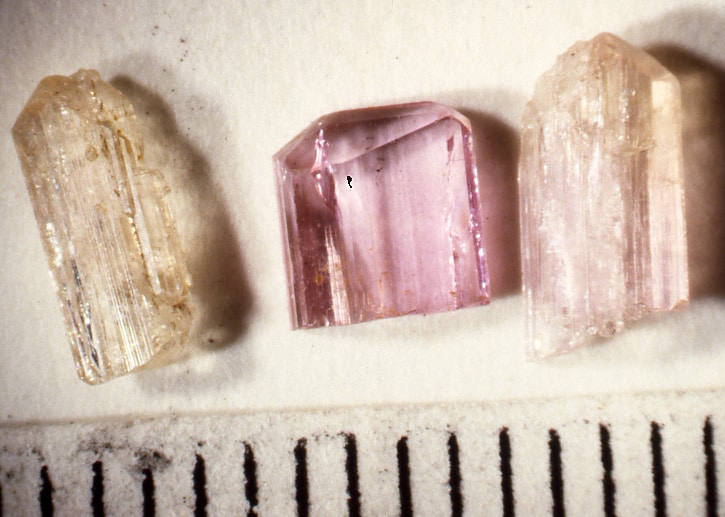
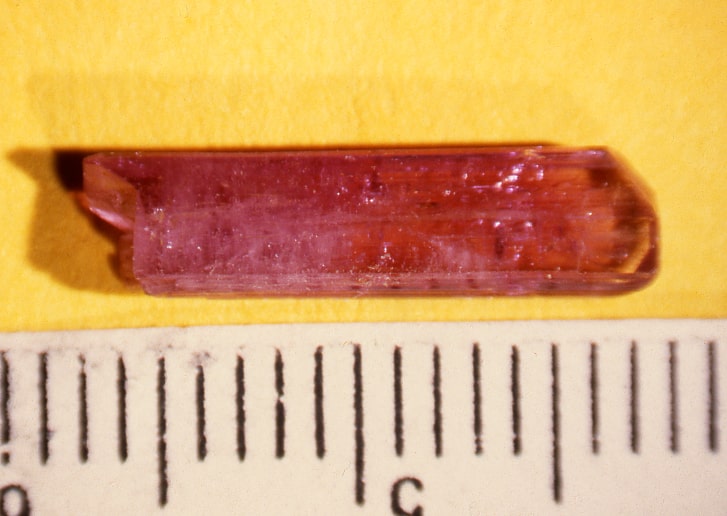
It doesn’t take much study of gem history to know that the only significant source of Imperial topaz at the time the piece was said to have been made was Ouro Preto, Brazil.
And, while we are on the subject of fine topaz I would like to address another legend that you can find in the literature, regarding precious or “Imperial” topaz. This legend has been published by Federman in his Gem Profiles , 1988″. I have found this legend on internet sites and heard it from jewellers. The legend goes that the derivation of the term Imperial stems from the discovery of pink topaz in Russia during the 19th century. The legend says: … The gem was instantly so coveted that ownership was restricted to the Czar, his family and those to whom he gave it as a gift.
But the Russian literature just cited contradicts this tale, completely. I would ask you to consider, as responsible gemmologists, whether we should shrug and let it go; or if the reputation of gemmologists is better served by trying to correct such fantasies when we find them, such as Katz suggests.
Next, let me touch on a famous Brazilian diamond, the Braganza of the Portuguese Crown, the present whereabouts of which is unknown. This enormous “diamond”, reportedly weighing 1680 carats, has for most if not all of its history been suspected to be a topaz. The various stories of this famous diamond I find fascinating, and provide a good source for romancing the stone. Lets see what a closer look at history can tell us. Gonsalves, writing in 1949, tells us that there is a “cloud” as to when it was discovered: some giving 1741, others 1764, and Sir John Mawe as late as 1797. The place of discovery is also in some question. Jones (1880) gives it as the Caetha Mirim ” mine” in 1741, and Dieulafait, (1874) as Cay de Merim, with no discovery date. On the other hand, John Mawe, writing in 1812, gives it as the Abaete River in the west of Minas Gerais. The color is also in question, being given from colorless to dark yellow. To add suspicion, the Portuguese Crown didn’t permit examination of the stone, and it was reportedly kept as a rough stone. It is generally associated with King Dom Joao VI, who reigned from 1792 to 1826.
However, Comstock in his Mineralogy of 1844, in describing large diamonds, says: The queen of Portugal was said to have possessed a diamond weighing 11 ounces. This stone is however said to be a white topaz.
Now 11 ounces comes to 1,710 ct— close enough to assume that this is the Braganza Comstock was talking about. If Comstock meant Queen and not Queen Consort, as seems probable, the only Queen to reign during this time was Dona Maria I,, who wasQueen from 1777 to 1792, at which time she was deposed, and Dom Joao VI became King. If, what Comstock say is true, then the Braganza was found prior to the date given by Mawe of 1797. Additionally, Gancalves notes that the Braganza was not inventoried in the estate of Dom Joao VI at his death in 1826. With this background I would like to look at what a little geology and history of the Brazilian diamond district can do to further enlighten us on the Braganza.
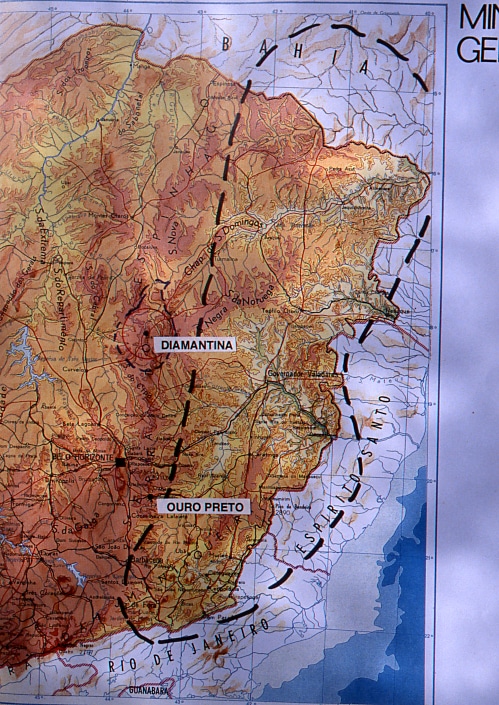
This slide (slide 4) shows the eastern part of Minas Gerais state where most of the early diamond production occurred. C. R. Boxer, (Golden Age of Brazil, 1962), gives an excellent and detailed history of the Brazilian diamond fields. The earliest diamond finds were in the Diamantina region dating to about the 1720’s as a result of washing for gold. Diamond production was from alluvial deposits on the upper reaches of the Jequitinhonia River and tributaries. The red circle is approximately the region where the Portuguese Crown limited access in the early days of diamond production. This is the famous Distrito Diamantino, which was viciously controlled by the Crown.
The earliest production, was by anyone paying taxes to the Crown, leading to high production and a sharp drop in diamond prices. The Crown was unhappy with this and in 1734 decreed that all diamond mining must cease. This lead to much illicit mining and the name given to these miners was garimpeiro. The ban remained for several years until the diamond prices rose. The garimpeiro remains today as a generally poorly educated, itinerant miner, but who produces most of the gems mined in Brazil. Formal production resumed in 1740 but by six contractors. About the time the Braganza first appears.
The Caete Mirim River, one local for the Braganza, is a tributary of the Jequintinhonia north of Diamantina. What is important for our story is that the diamonds from this district are generally small and have been transported for some distance leading to high production of fine stones, much as has happened on the Namibian Coast. The primary kimberlitic source is unknown. The secondary source is Precambrian conglomerates, formerly ancient river gravels, which outcrop in the higher parts of the Serra do Espinacho, the dashed black outline surrounding the red Distrito Diamantino. Professor Haralyi (1991) notes stones of 20 to 64 ct as the largest. Additionally, there are no sources for topaz in the Distrito Diamantino either.
Slide 5. (not illustrated) Photo of Guinda garimpo in 2000, worked from early days of diamond production and showing large blocks of the Sopa conglomerate. slide 6 (not illustrated) Close up view of the diamond-bearing Sopa conglomerate.
Back to slide 4
The large area outlined by the black dashed line is the region of pegmatites which are famous for production of beryl, tourmaline, topaz and other coloured gems. As you can see the reqion is not far from the diamond district, and easily accessible down the Jequitinhonia. Some of you will recognize the village of Virgem da Lapa where fine topaz occurs. Thus there is a source of large fine topaz not far downstream from the diamond district.
We can conclude that, most probably, the Braganza didn’t come from the Distrito Diamantino— be it diamond or topaz. We will probably never know how or why the discovery place was assigned to the Caete Mirim river; but my best guess is that the Braganza was a topaz that found its way to Diamantina where it could be better passed off as a true diamond.
Slide 8 (not illustrated) Casa da Gloria a fine estate aquired by Dona Josefa Maria da Gloria it the end of the 18th century, hence the name, and where John Mawe, Saint Hilaire, D’Orbigny Richard Francis Burton , and yours truly stayed while in Diamantina. Presently owned by the Instituto de Geociencias, Universidade de Minas Gerais.
Now, lets go back to the Braganza and the western part of M.G. where truly large diamonds are really found.
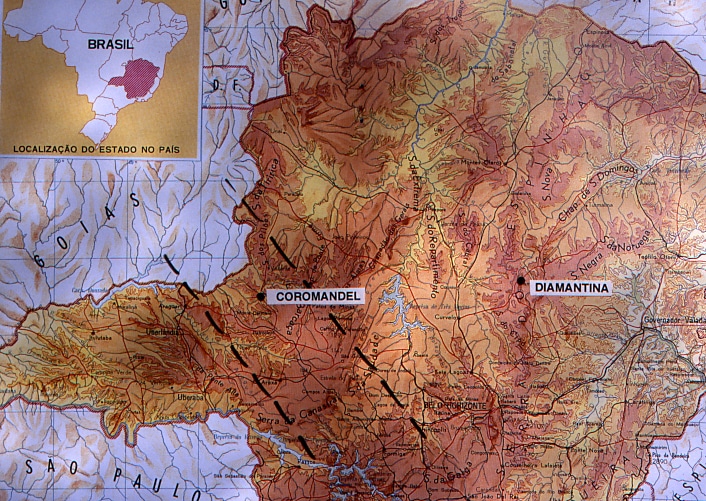
They occur in the Bagagem/Golconda region, called by the Brazilians the Alto Parnaiba. The site that Mawe gives for the Braganza is the Abaete River, a tributary of the large Sao Francisco system, and located about at the L in Coromandel. Leonardos, writing in 1939 on large Brazilian diamonds, suggests that the Braganza may in fact have been a true diamond because of all the other large diamonds that came from this small region.
Let’s look at this more closely. The earliest large Brazilian diamond we know of is the Empress Eugenia that was found in the 18th century; Goncalves says 1760. Its rough size is unknown but cut it is 52 ct. So the rough would have been over 100 ct. No locality is given, but from the size it probably is from the Golconda region. Next, Leonardos informs us of a Royal Decree dated 24 May, 1797 granting a reward and employment to Manuel A. F. Sarmento, and others, for the discovery of a 139.5 ct diamond on the Abaete River in late 1796. The same place and time Mawe gives for the Braganza. Next, Comstock in 1844, notes that the King of Portugal possesses a diamond of 215 ct. But we don’t know if that is rough or cut. No locality is given either; but again it probably is from here. It is not until 1853 that we have good information on the Estrella do Sul that was found at Bagagem and weighed 261 ct in the rough.
Now, in November of 1807, Dom Joao VI had to beat a hasty retreat from Portugal due to the approach of Napoleon’s troops to Lisbon; taking the Crown to Brazil and what possessions he could rapidly gather. Mawe next enters the scene in 1809 when he makes his extensive travels in Brazil under the authority of Dom Joao VI. One can’t help being suspicious that Dom Joao, knowing of the large diamond or diamonds from the Abaete region, and probably needing to maintain an illusion of the Braganza being a diamond, provided Mawe the tale he related of the date and place of discovery, making it the same date and place as the 139.5 ct stone. Of course this is speculation, but it seems reasonable.
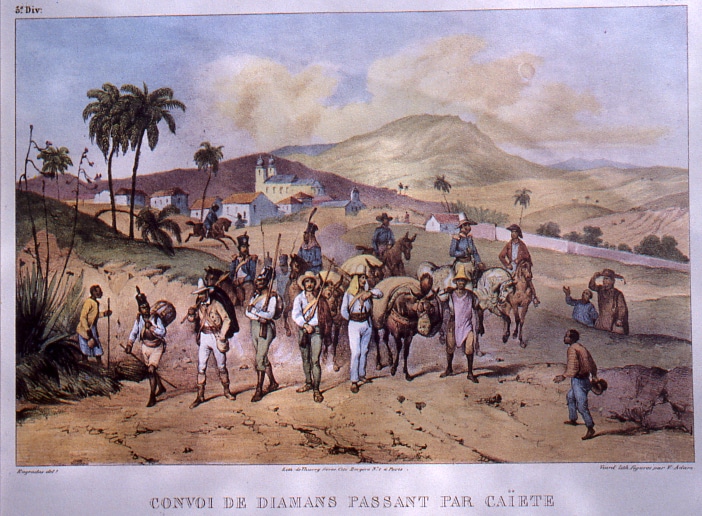
Although one can’t rule out that the Braganza was a true diamond, if it came from this area, the differing and incompatible stories, the reluctance of the crown to permit testing, and the complete disappearance of the stone suggest, I believe, that it most probably was topaz.
I hope this shows how much more information may be obtained with a closer look at gem history.
This can be further illustrated by considering other diamonds from the Alto Parnaiba of Brazil. What most gemmologists don’t realize is that, next to South Africa, this small region has produced more large rough diamonds than any other in the world. Of the 31 world’s largest rough diamonds listed by Bruton in his 1970 book, eight (8) are from this region. These are stones over 324 cts. Leonardos tell us that the six year period of 1934 – 1940 officially yielded a total of 16 diamonds weighing from 80 to 726 carats. Large stones are still coming from the region according to some of my sources; but little is known of them as they disappear into the black market.
But, before I leave this Alto Parnaiba region there is another tale I want you to know about. In Bruton’s list of large rough diamonds, the 10th largest listed is the Goyaz.
This really doesn’t tell the whole story. You may note that obtaining a 80 ct stone from a 600ct rough is rather poor yield; but we know nothing about the shape of the rough or what kinds of internal flaws may have been present—so it is not unreasonable. Now, if I tell you that Bruton is in error, and that the largest gem cut from this 600 ct piece was only 8 ct, you may begin to wonder why. The story is taken from a study by Dr O. Derby, published in the American Journal of Science in1912. The rough was found in 1906, by a garimpeiro working the Rio Verissimo in Goyas state. This is a little north and west of Coromandel and Bagagem. This garimpeiro, not being well educated, and not knowing the difference between hardness and toughness, but having heard how hard diamond was … yes you guessed it … he put this approximately 600 ct stone on an anvil and with his hammer he hit it. Needless-to-say it was smashed to bits; the largest fragment yielding an 8 ct, not an 80ct stone as Bruton tells us. Derby was able to collect about 100 ct of the broken pieces, after the fact, to estimate that the original was approximately 600 cts in weight. Here we have a good example of what Professor Katz was referring to as a “sham publication”. It will be interesting to see how this error may be propagated in the future.
Next, I would like to change tack a bit and consider what may be learned about techniques for identification. Now, I hope you recognize what this jeweler is doing.
In this charming woodcut taken, from Dieurlafait and printed in 1874, a jeweller is shown holding a gem in tweezers and looking at a candle flame to see the double refraction. Most here will recognize an earlier Alan Hodgkinson practicing the “Visual Optics” technique. Of course, the question is why was this very simple and useful tool forgotten after the turn to the 20th century? It was rediscovered by Alan in the 1970’s. My main point here is that this tool was well known in the later half of the 19th century, being mentioned in a number of gem texts.
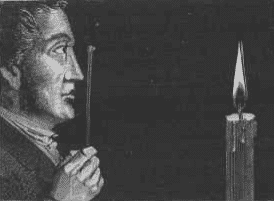
You might guess that the technique really wasn’t well enough known during the time. However, an interesting story about this use is given by Rambosson in his Les Pierres Precieuses, (1870) suggests this story must have had wide dissemination.
The stone in question was thought to be a diamond, owned by a Clemens S. Dupoisat of France. It had been looked on by many as one of the most beautiful diamonds in the world and the largest cut diamond known at 819 ct. The Athenee des Artes, Sciences et Belles lettres de Paris had also issued a certificate to the effect that it was the largest cut diamond known. The stone had quite a bit of press at the time, due to its enormous value. However there was some question as to its identity by many in the trade in Paris. The owner, however, was not willing to trust in French experts. I’m sure of Rambosson’s displeasure and he sent it to Germany for verification, where the Austrian mineralogist W. K. Haidinger examined the stone. Haidinger published a short paper on his results in 1858; but it was probably not nearly as well known as the account by Rambosson.
Let me read part of a translation from Rambosson of part of the report by Haidinger:
The volume of the stone, which moreover is very well made after the shape of the Regent or Pitt, is truly remarkable, in height it is 43 mm, in diameter 53 mm, its weight is 168 gramms, or 819cts. It is perfectly transparent, and its colour a little bit blueish. Among transparent substances single refraction is able to show diamond or stones of strass (glass); double refraction, rock crystal, white beryl, or topaz. I began to examine the stone under the point of view of this physical property so easy to determine. I looked at the flame of a candle through two artificial facets considerably inclined to each other, between 40 to 45 degrees; for example the table of the brilliant and one of the inclined facets on the inferior summit , called the pavilion by the lapidaries. One distinguishes easily the two images of the flame colored by refraction. placed one on the other, and polarized perpendicularly one to the other when looked at through a tourmaline plate.
All the members of the commission and the owner of the stone have viewed the two images. It is without question neither a diamond or another singly refractive stone.
What a marvelous story, and one that must have had a lot of telling during the later half of the 19th century. But, why was the visual optics technique not remembered into the 20th century? This is a real puzzle to me. I believe it does show what a little look at history can turn up not only in tricks of the trade that have been forgotten, but in providing exciting true tales by which to capture the interest of all lovers of fine gems.
It also is curious why nothing appears to be known about the rough from which the Dupoisat diamond was cut. It is interesting to consider that this diamond appears about the time the Braganza disappeared. We do know that the French, when forced to withdraw from Portugal, shipped a large amount of loot to France, and perhaps the Braganza was included.
I see my time is up, so I’d like to thank you for your attention and leave you with one last thought —
gemmologists are facetnating
(ed.: not all slides could be retrieved for this publicatio